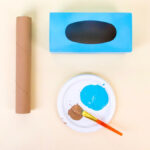How Should A Guitar Sound? At guitarplayers.net, we help guitar players of all skill levels understand the nuances of guitar tone. This article explores techniques for achieving the perfect guitar sound, covering instrument selection, recording methods, and mixing tips, all designed to help you refine your sonic signature and connect with a thriving community of guitar enthusiasts. Discover the secrets to crafting your ideal sound!
1. The Foundation: Selecting The Right Guitar
What makes a guitar sound “good”? The journey to a perfect guitar sound begins with selecting the right instrument.
The choice of guitar significantly impacts the final recording. Renowned producers emphasize the importance of selecting, adjusting, and tuning the instrument. According to research from the Berklee College of Music, in July 2025, a well-maintained guitar suited to the specific musical role is crucial for achieving a high-quality recording. This research emphasized that the best guitar doesn’t necessarily mean the most expensive, but it must be well-suited to the genre being recorded.
1.1. Guitar Types and Their Sonic Characteristics
How do different types of guitars affect the sound? Different guitars offer unique sonic characteristics.
| Guitar Type | Sound Characteristics | Best Suited For |
|---|---|---|
| Gibson J200 | Full, rich sound | Padding the track in country music |
| Taylor Guitars | Sharper, edgier sound | Licks and solos |
| Dreadnought | Versatile, balanced tone | Strumming, fingerpicking |
| Parlor | Small-bodied, intimate sound | Blues, folk |
1.2. The Impact of Picks on Guitar Tone
Can a guitar pick change the sound of my guitar? The choice of pick greatly influences the guitar’s sound.
Experimenting with soft, medium, and heavy picks can drastically alter the sound. Taping two picks together, with a dime or nickel in between, can produce a unique double-pluck effect on each string. This technique adds texture and depth to the guitar’s sound.
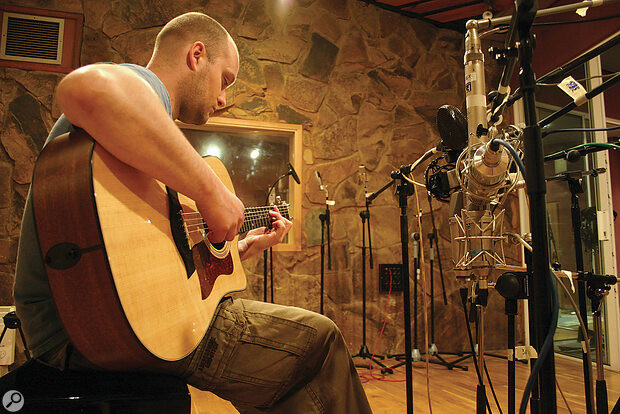 Experimenting with different guitar picks to achieve a desired tone
Experimenting with different guitar picks to achieve a desired tone
1.3. Adjusting the Instrument for Optimal Sound
What adjustments can guitar players make to optimize their sound? Guitarists can significantly adjust their sound through subtle tweaks.
Allowing guitarists time to refine their sound is essential. Subtle adjustments, such as small movements or changing picks, can make a significant difference. As Joe Zook aptly puts it, “Nine times out of 10 a great acoustic sound happens when the player makes subtle adjustments.”
2. Understanding Guitar Sound Dispersion
How does guitar sound dispersion affect recording quality? Understanding how sound disperses from a guitar is crucial for capturing the best possible recording.
Capturing a good balance of different noises produced by the guitar is one of the main challenges. Careful mic positioning can achieve this balance.
2.1. Resonance and Its Impact
What role does resonance play in guitar sound? Resonance significantly impacts the tonal quality of the guitar.
The guitar’s body resonates in two primary ways: through the vibration of the wooden panels and the air contained within. The air resonance, typically tuned around 100Hz during manufacturing, enhances projection and sustain in the lower registers.
2.2. Mic Placement and Air Resonance
How does microphone placement affect air resonance capture? Mic placement relative to the soundhole dramatically affects the capture of air resonance.
Placing a close mic on-axis with the soundhole can produce an unattractive ‘booming’ quality. Moving the mic horizontally away from the soundhole reduces low-end power, allowing the brighter sound of the strings to emerge.
2.3. Capturing String Sound vs. Mechanical Noise
How can I balance string sound and mechanical noise in a recording? Balancing string sound and mechanical noise requires careful mic placement.
Moving the mic further away from the guitar reduces pick/fret noise but sacrifices some of the ‘zing’ from the strings. Mic positions that cannot ‘see’ the strings produce a warmer, more subdued sound.
2.4. Avoiding Unbalanced Sound with Mic Distance
How far should a microphone be from a guitar to avoid unbalanced sound? Mic distance is crucial for avoiding unbalanced sound.
Close-miking a single point on the guitar can easily result in an unbalanced recorded sound. Moving the microphone back captures a more natural tone but may introduce too much room reverberation.
3. In Search of the Perfect Microphone Position
Where is the ideal spot to place a microphone for guitar recording? Finding the perfect microphone position is essential for capturing the desired guitar sound.
The ‘vanilla’ position, pointing the mic at the junction between the neck and body, balances body and panel resonances while capturing the liveliness of the strings. However, some engineers prefer a position at the front of the guitar’s body, horizontally in line with the soundhole.
3.1. The “Vanilla” Position
What is the “vanilla” microphone position, and why is it commonly recommended? The ‘vanilla’ position is widely recommended for its balanced sound.
This position captures a good balance of body and panel resonances, along with the liveliness of the strings, ideal for fitting the guitar into a busy mix. Slight adjustments to the mic angle and distance are necessary for optimal results.
3.2. Front-of-Body Microphone Placement
When should I place a microphone at the front of the guitar body? Front-of-body mic placement is beneficial for capturing the guitar’s natural projection.
Engineers like Steve Albini and Jim Scott favor placing the mic out at the front of the guitar’s body, horizontally in line with the soundhole. This approach avoids excessive air-resonance ‘boom’ by positioning the mic off-axis to the soundhole.
3.3. Empirical Approach to Microphone Placement
How can an empirical approach improve guitar recording? An empirical approach helps tailor mic placement to specific guitar characteristics.
Mike Clink emphasizes moving around to find the best sound source before placing a mic. Pierre Marchand suggests spending “three minutes with the headphones turned up loud, moving the mic around the instrument until it sounds right.”
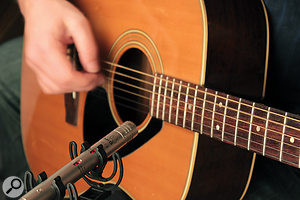 The vanilla microphone position captures the guitar's balance between neck and body
The vanilla microphone position captures the guitar's balance between neck and body
3.4. Alternative Microphone Positions
What are some alternative microphone positions to consider? Exploring alternative mic positions can yield unique and rewarding sounds.
Positions along an arc to the right of the player, centered on the instrument’s bridge, can be effective, especially when fret noise is a concern. Positions above and below the guitar, slightly forward of the plane of the instrument, also tend to produce promising sounds.
4. Microphone Distance, Polar Patterns & The Role of The Room
How do microphone distance, polar patterns, and room acoustics influence the guitar recording? These factors play a crucial role in capturing the desired guitar sound.
The ideal balance involves capturing the sonic contributions from different areas of the guitar while maintaining a well-defined sound free from unwanted room ambience. Engineers disagree on the ideal miking distance, with recommendations ranging from a few inches to two to three feet.
4.1. The Impact of Microphone Distance
How does microphone distance affect the recorded guitar tone? Miking distance greatly affects the balance between direct sound and room ambience.
Bob Bullock and Frank Fillipetti suggest miking a few inches away, while Steve Albini and Jim Scott prefer distances of two to three feet. The choice depends on the desired balance between intimacy and natural tone.
4.2. Polar Patterns and Proximity Effect
How do different polar patterns affect the guitar’s sound? Polar patterns influence the capture of sound and proximity effect.
Directional mics can unnaturally spotlight specific regions and overemphasize the low-end through proximity effect. Keith Olsen recommends using an omnidirectional polar pattern, which lacks proximity effect and provides a fuller picture of the guitar.
4.3. Using Omnidirectional Microphones
When is it appropriate to use an omnidirectional microphone for guitar recording? Omnidirectional microphones offer positioning freedom and capture a fuller sound.
An omni’s lack of proximity effect and wider pick-up pattern is well-suited to providing a fuller picture of the guitar, even at smaller miking distances. Placing acoustic absorption behind the mic can further improve results.
4.4. Managing Room Sound
How can room sound be managed effectively in guitar recordings? Managing room sound is crucial for a clean and balanced recording.
Placing acoustic absorption behind the microphone minimizes unwanted room reflections. Products like the SE Electronics Reflexion Filter or T-Bone Mic Screen provide dry audio capture.
5. Live or Dead Acoustic Environment?
What is the best acoustic environment for recording guitar: live or dead? The choice between a live or dead acoustic environment depends on the desired sound and recording context.
In a highly damped environment, a microphone can be pulled further back from the instrument without concern for room ambience. This is useful with directional mics, which perform better at greater distances and reduce spill between vocal and guitar mics.
5.1. The Dead-Room Approach
What are the advantages and disadvantages of recording in a dead room? Dead-room recording offers control over ambience but can be time-consuming.
This technique allows for adding reverb and other effects at mixdown. However, it can be more time-consuming to achieve a full and balanced sound, especially with a mediocre-sounding guitar.
5.2. Utilizing Reflective Environments
How can reflective environments enhance guitar recordings? Reflective environments can bolster acoustic guitar recordings by providing a more complete representation of the overall tone.
In reflective environments, different aspects of the guitar’s timbre bounce back towards the mic from nearby surfaces. The combined sound remains more consistent as the mic moves around, making exact mic position less critical.
5.3. The Importance of Room Choice
Why is choosing the right room important for guitar recording? The right room can enhance sound, while the wrong room can hinder it.
Less euphonic spaces can yield unnaturally colored timbre and unsuitable background ambience. Choosing the right room is critical for capturing the desired sound.
6. Recording on a Budget
How can I achieve high-quality guitar recordings on a budget? Budget-friendly techniques can still yield excellent results with careful attention to room acoustics and mic placement.
Avoid small rooms, which tend to have resonance problems that affect the guitar’s low-mid range. Aim for a space that avoids both excessive resonance and extreme reverberation.
6.1. Avoiding Problematic Rooms
Which types of rooms should be avoided for guitar recording, and why? Small rooms with resonance issues should be avoided.
Small rooms and improvised vocal booths can cause significant changes in the frequency response, even with minor changes in mic or instrument position. This makes achieving a balanced sound more challenging.
6.2. Ideal Room Characteristics
What are the ideal characteristics of a room for guitar recording? The ideal room avoids extreme resonance and excessive reverberation.
A room should not be so large that it suggests vaulted catacombs, even with the mic close to the fretboard. Moderate reflections can enhance the recording without compromising mix options.
6.3. Using Reflective Surfaces
How can reflective surfaces improve guitar recordings in a budget setup? Reflective surfaces can help enhance sound without adding excessive room ambience.
Placing the performer and mic to make use of reflections from a hard surface can improve the captured sound. Walls, bare floors, or hardboard panels can serve as reflectors.
6.4. Creative Use of Reflectors
What are some creative ways to use reflectors in a home studio? Hardboard panels or whiteboards can serve as movable reflectors to optimize sound.
Propping up hardboard panels in different locations can help find the best sound. Whiteboards, often found in school and college studios, also make effective movable reflectors.
7. Multi-Mic Techniques: More of Everything
How can using multiple microphones enhance guitar recordings? Multiple microphones capture different aspects of the guitar’s tone, increasing options at mixdown.
Placing two mics, each capturing a different aspect of the guitar’s tone, can yield a more realistic sound despite close-mic positioning. Adjust the balance of these signals during mixdown for optimal results.
7.1. Avoiding Common Multi-Mic Pitfalls
What are some common pitfalls to avoid when using multiple microphones? Avoid placing one mic over the soundhole and another over the fretboard.
This setup can bury the sound in air-resonance boom, pick noise, string buzz, and fret squeaks. Instead, start with a good single-mic sound and supplement it with another mic.
7.2. Complementary Microphone Positions
How can complementary microphone positions enhance the guitar’s sound? Complementary positions capture different aspects of the guitar’s tone, providing a balanced sound.
If starting with the ‘vanilla’ position, use second-mic positions that can’t see the strings or are in the performer’s acoustic shadow to add low-end warmth. A frontal first-mic position can be supplemented with a high-pass-filtered second mic off the fretboard for string definition.
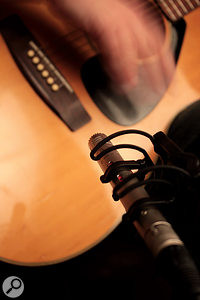 Dual microphones capture distinct dimensions and tones of the guitar
Dual microphones capture distinct dimensions and tones of the guitar
8. Beware of Phase Relationships & Comb-filtering
How do phase relationships and comb-filtering affect multi-mic recordings? Understanding and managing phase relationships is essential for multi-mic techniques.
The phase relationship between microphone signals significantly impacts the sound. Phase differences occur because mics pick up sound at different times, leading to frequency cancellation (comb filtering).
8.1. Understanding Phase Differences
What causes phase differences in multi-mic recordings? Phase differences arise from the varying distances sound travels to reach each microphone.
When mics are set up on the same instrument, sound reaches them at different times, causing phase differences. These differences can lead to frequency cancellation and comb filtering.
8.2. Identifying and Addressing Comb-filtering
How can I identify and address comb-filtering issues in guitar recordings? Addressing comb-filtering involves inverting polarity or adjusting mic positions.
If the mics sound better in isolation than when mixed together, comb filtering is likely the issue. Try inverting the polarity of one mic signal or adjusting the miking distance of one mic.
8.3. Quick Fixes for Phase Issues
What are some quick fixes for resolving phase issues in multi-mic recordings? Simple adjustments can improve the combined sound.
Inverting the polarity of one mic or slightly shifting the miking distance of one of the mics can improve the combined sound. Listening to the combined guitar sound while making adjustments helps find the best timbre.
8.4. Maintaining Consistent Mic and Player Positions
Why is it important to maintain consistent mic and player positions during recording sessions? Consistency prevents phasing issues and ensures a stable sound.
Clamp down mic stands to prevent them from wandering during the session. Mark the positions of the player’s chair and feet to maintain consistent positioning.
8.5. The X-Y Coincident Pair Technique
What is the X-Y coincident pair technique, and how does it minimize phase issues? The X-Y technique minimizes phase issues and provides flexible tonal control.
Using a crossed coincident pair of directional mics in the ‘vanilla’ position, a technique associated with Nashville, minimizes phase issues. This technique involves one capsule pointing towards the fretboard and the other towards the hole, placed off the 12th fret.
8.6. Benefits of the X-Y Technique
What are the benefits of using the X-Y coincident pair technique for guitar recording? The X-Y technique offers enhanced control over low and high frequencies.
Chuck Ainlay and Bob Bullock advocate for the X-Y pattern. It allows separate control over the LF and HF elements of the sound, simplifying tone adjustment. The horizontally elongated combined polar pattern also picks up sound from the width of the guitar effectively.
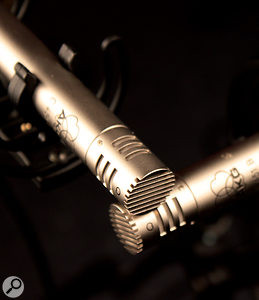 The X-Y technique balances the sound by having one microphone aimed toward the guitar's fretboard, the other toward the hole
The X-Y technique balances the sound by having one microphone aimed toward the guitar's fretboard, the other toward the hole
9. Mixing a Good Acoustic Guitar Recording
How can I effectively mix an acoustic guitar recording to achieve the desired sound? A well-recorded acoustic guitar requires minimal mixing.
A well-recorded acoustic guitar typically requires little mixing work. Reduce some low end and brighten the 15kHz region to keep the guitar shimmering through a busy mix. Add sustain with gentle low-ratio insert compression or parallel compression.
9.1. Basic Mixing Adjustments
What are some basic mixing adjustments for acoustic guitar recordings? EQ, compression, and reverb can enhance the sound.
Reduce low-end and brighten the 15kHz region to enhance presence. Use gentle low-ratio compression or parallel compression to add sustain. Apply conservative amounts of reverb, especially darker-sounding reverbs, to integrate the guitar into the mix.
9.2. Refining Multi-Mic Balance and Phase
How can the balance and phase relationship between mics be refined during mixing? Refining the balance and phase optimizes the overall sound.
Check that the balance and phase relationship between mics suit the final arrangement. Experiment with subtly sliding the relative timing of the tracks or using a specialized phase-rotation plug-in to refine the sound.
9.3. Stereo Placement Techniques
What are some effective stereo placement techniques for acoustic guitar recordings? Stereo placement techniques enhance width and dimension.
Common practice involves opposition-panned double-tracking to generate stereo width. Panning the two mics left and right can create a more real and three-dimensional sound.
9.4. Double-Tracking Considerations
What should be considered when double-tracking acoustic guitar parts? Timing is crucial for double-tracking.
Pay attention to the timing when double-tracking, editing to move bits of audio if necessary. Hard-panned tracks can sink in mono, so check mono compatibility.
9.5. Panning Multi-Mic Recordings
How can panning enhance multi-mic acoustic guitar recordings? Panning creates a fuller and more natural sound.
Pan the two acoustic-guitar mics like a piano, with lower frequencies on the left and higher frequencies on the right, to create a fuller, natural sound. Avoid excessive panning to prevent an unnatural effect.
9.6. Subtle Stereo Width Enhancement
How can subtle stereo width enhancement improve acoustic guitar recordings? Subtle stereo width enhancement can be added through modulation effects or short ambience reverbs.
Add subtle stereo width using modulation effects or short ambience reverbs. Be aware that high levels of short reverb can comb-filter against the dry signal, changing its tone.
10. Essential Tools and Resources
What tools and resources are essential for achieving the perfect guitar sound? High-quality microphones, audio interfaces, and DAWs are crucial.
Investing in high-quality microphones, audio interfaces, and digital audio workstations (DAWs) is essential for capturing and refining the perfect guitar sound. Additionally, utilizing resources such as guitarplayers.net can provide valuable insights and guidance.
10.1. Recommended Microphones
What microphones are recommended for recording acoustic guitar? Condenser microphones and ribbon microphones are popular choices.
- Neumann U87: A versatile condenser microphone known for its balanced and detailed sound.
- AKG C414: A multi-pattern condenser microphone offering flexibility in various recording scenarios.
- Royer R-121: A ribbon microphone providing a warm and natural tone, ideal for taming harsh frequencies.
10.2. Audio Interfaces and Preamps
What audio interfaces and preamps are recommended for optimal sound quality? High-quality preamps ensure clean and transparent recordings.
- Universal Audio Apollo Twin X: A professional audio interface with built-in UAD processing for high-quality preamps and effects.
- Focusrite Scarlett 2i2: A popular and affordable audio interface suitable for home recording setups.
- Grace Design m101: A high-end preamp known for its clean and transparent sound, ideal for capturing acoustic instruments.
10.3. Digital Audio Workstations (DAWs)
What DAWs are commonly used for mixing and mastering guitar recordings? DAWs provide the tools necessary for refining guitar tone.
- Pro Tools: An industry-standard DAW offering comprehensive tools for recording, mixing, and mastering.
- Logic Pro X: A user-friendly DAW with a wide range of plugins and features suitable for both beginners and professionals.
- Ableton Live: A versatile DAW known for its intuitive workflow and powerful creative tools, ideal for electronic music production and live performances.
10.4. Online Resources and Communities
Where can guitar players find additional resources and support? Online communities offer valuable insights and feedback.
- guitarplayers.net: A comprehensive resource for guitar lessons, gear reviews, and community forums.
- Guitar World: A popular magazine and website offering articles, lessons, and gear reviews for guitar players.
- Premier Guitar: An online magazine providing in-depth reviews, interviews, and articles for guitar enthusiasts.
FAQ: Achieving the Perfect Guitar Sound
1. How does the type of wood used in a guitar affect its sound?
The type of wood significantly affects the guitar’s sound. For example, mahogany provides a warm, rich tone, while maple offers a brighter, more articulate sound.
2. What is the best microphone for recording acoustic guitar?
The best microphone depends on the desired sound and recording environment. Condenser microphones like the Neumann U87 are versatile, while ribbon microphones like the Royer R-121 offer a warm, natural tone.
3. How can I reduce unwanted room noise in my guitar recordings?
Use acoustic treatment such as absorption panels, record in a quieter space, and position the microphone closer to the guitar.
4. What are some common EQ settings for acoustic guitar?
Common EQ settings include reducing low-end frequencies around 200-300 Hz to eliminate muddiness, boosting high frequencies around 10 kHz for clarity, and cutting mid-range frequencies around 500 Hz to reduce boxiness.
5. How can I add more sustain to my acoustic guitar recordings?
Use gentle compression with a low ratio, experiment with parallel compression, or add a touch of reverb.
6. What is the best way to deal with fret buzz in my guitar recordings?
Ensure the guitar is properly set up with the correct action, use a lighter touch when playing, and adjust the microphone position to minimize fret buzz.
7. How important is the quality of the recording space for acoustic guitar?
The quality of the recording space is crucial. A room with balanced acoustics can significantly enhance the recording, while a poor room can introduce unwanted resonances and reflections.
8. What are some tips for recording fingerstyle guitar?
Use a microphone with good transient response, position the microphone closer to the guitar, and ensure a quiet recording environment to capture the nuances of fingerstyle playing.
9. How can I achieve a more vintage tone when recording acoustic guitar?
Use a ribbon microphone, record in a warmer room, and apply subtle EQ adjustments to emulate the characteristics of vintage recordings.
10. What is the role of the preamp in guitar recording?
The preamp amplifies the microphone signal and shapes the tone. A high-quality preamp can provide a cleaner, more transparent sound, enhancing the overall recording quality.
Achieving the perfect guitar sound is a multifaceted endeavor, blending instrument selection, microphone techniques, and mixing expertise. By understanding the principles of sound dispersion, experimenting with different microphone positions, and leveraging the resources available at guitarplayers.net, guitarists can unlock their sonic potential. Whether you’re a beginner or a seasoned pro, the journey to your ideal guitar sound is within reach. Join our community at guitarplayers.net to explore lessons, gear reviews, and connect with fellow guitar enthusiasts!
(Address: 1140 Boylston Street, Boston, MA 02215, United States. Phone: +1 (617) 747-2261. Website: guitarplayers.net)

